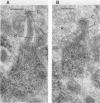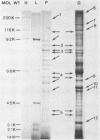Abstract
The recently discovered mycoplasma species Mycoplasma genitalium was isolated from urethral specimens from men with nongonococcal urethritis (Tully et al., Lancet i:1288-1291, 1981). In a previous report (K. Lind, Lancet ii:1158-1159, 1982), prominent serological cross-reactions were demonstrated between this mycoplasma and M. pneumoniae. In the present study, the two mycoplasma species were compared more extensively. In classical mycoplasma medium without thallium acetate, M. genitalium grew more slowly than M. pneumoniae did but finally formed similar amounts of acetic acid and lactic acid from glucose. Although their colonies on solid medium were indistinguishable, transmission electron microscopy showed that the flask-formed cells of M. genitalium (especially their necks) were shorter than those of M. pneumoniae. The two species were distinct since DNA hybridization showed only 1.8% homology in base sequences, and sodium dodecyl sulfate-polyacrylamide gel electrophoresis revealed significantly different profiles of the two strains. However, considerable similarities were found in their antigenic reactions in various serological tests. The presence of common or closely related antigens was demonstrated in the two species with rabbit immune sera in complement fixation test with chloroform-methanol-extracted antigens by an indirect immunofluorescence test on microcolonies, and by metabolism inhibition and growth inhibition tests. Cross-reactions were also demonstrated by crossed immunoelectrophoresis. The role of M. genitalium as a human pathogen in the genital tract has not been assessed. If serological tests are to be used in this assessment, caution must be exercised due to the extensive cross-reactions demonstrated. Some of the species-specific antigens which we have demonstrated would be appropriate for use in such tests and would help to circumvent problems caused by cross-reactions.
Full text
PDF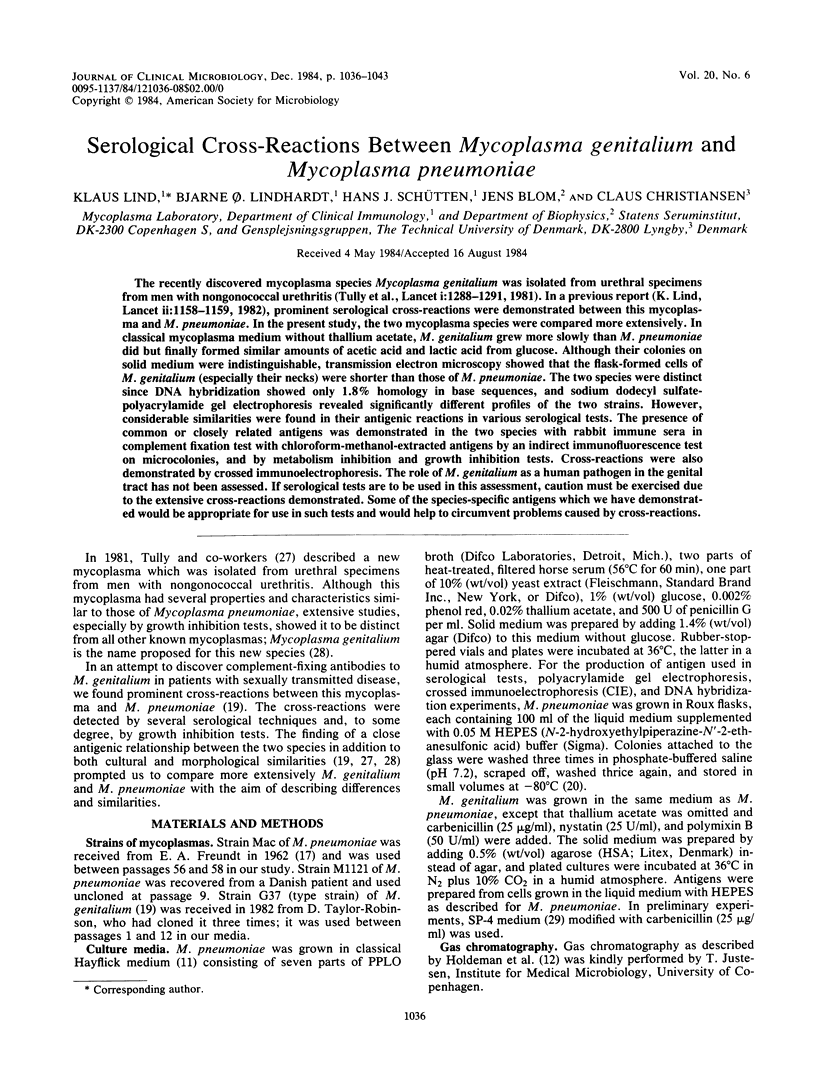
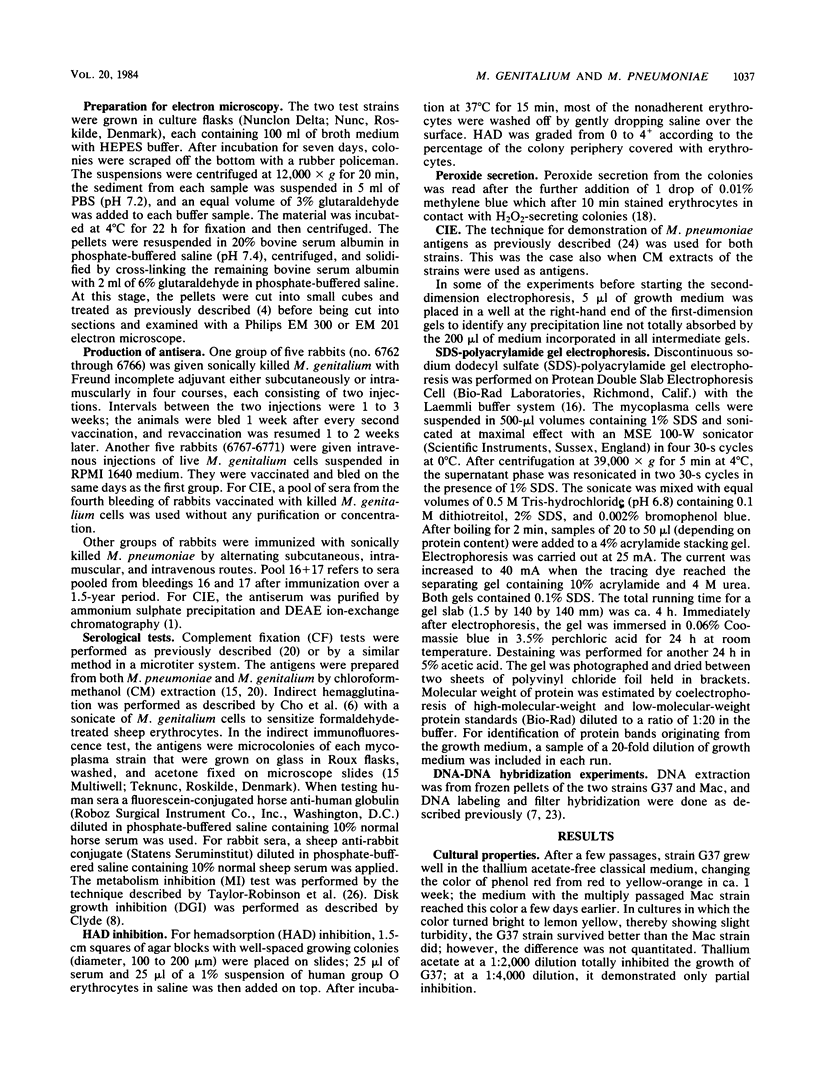
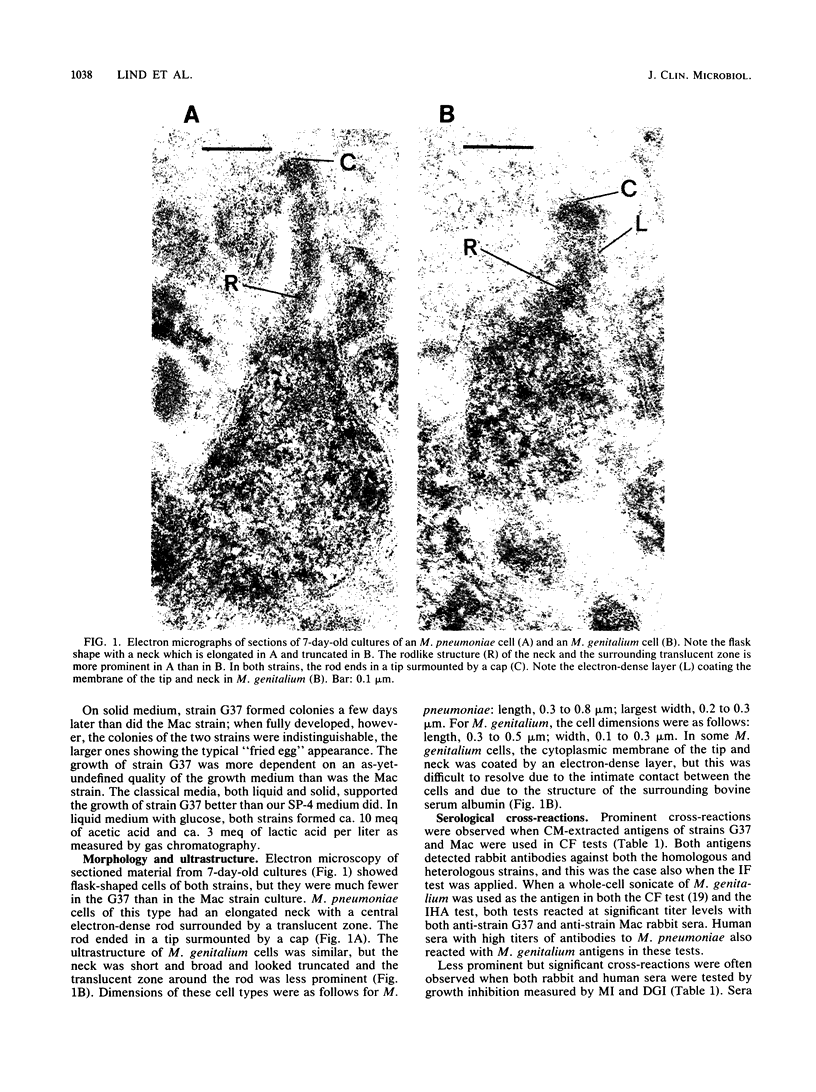
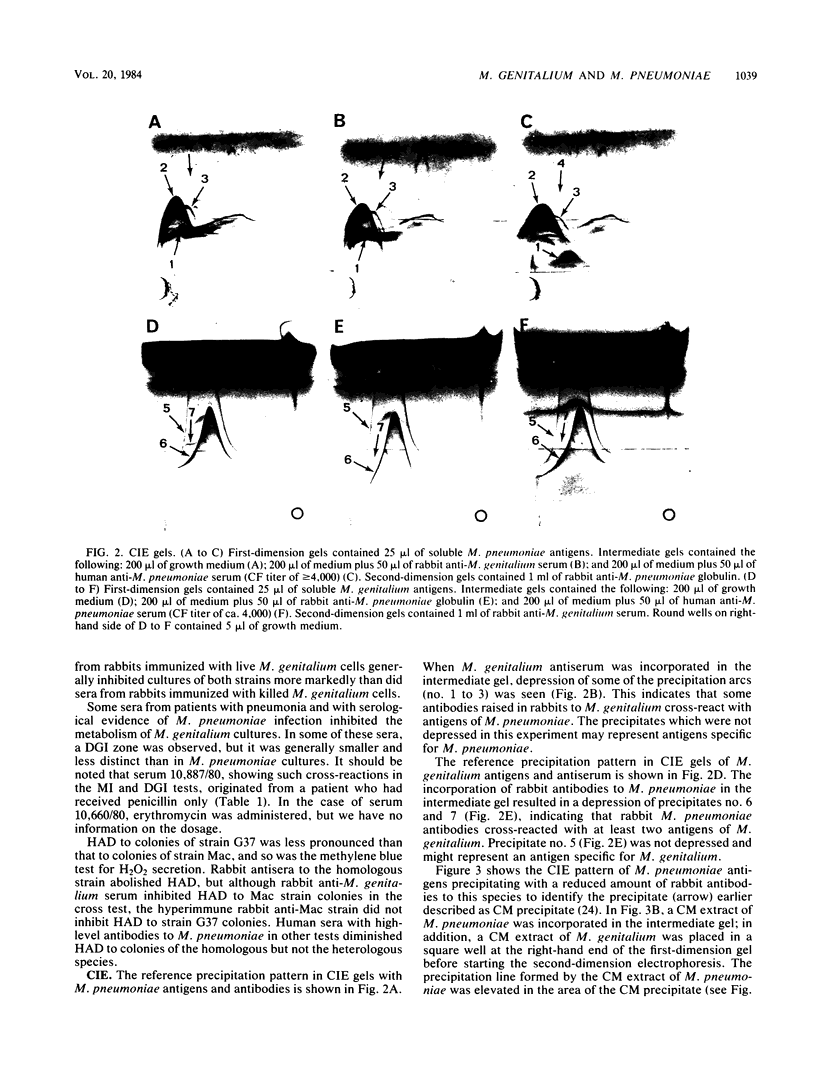
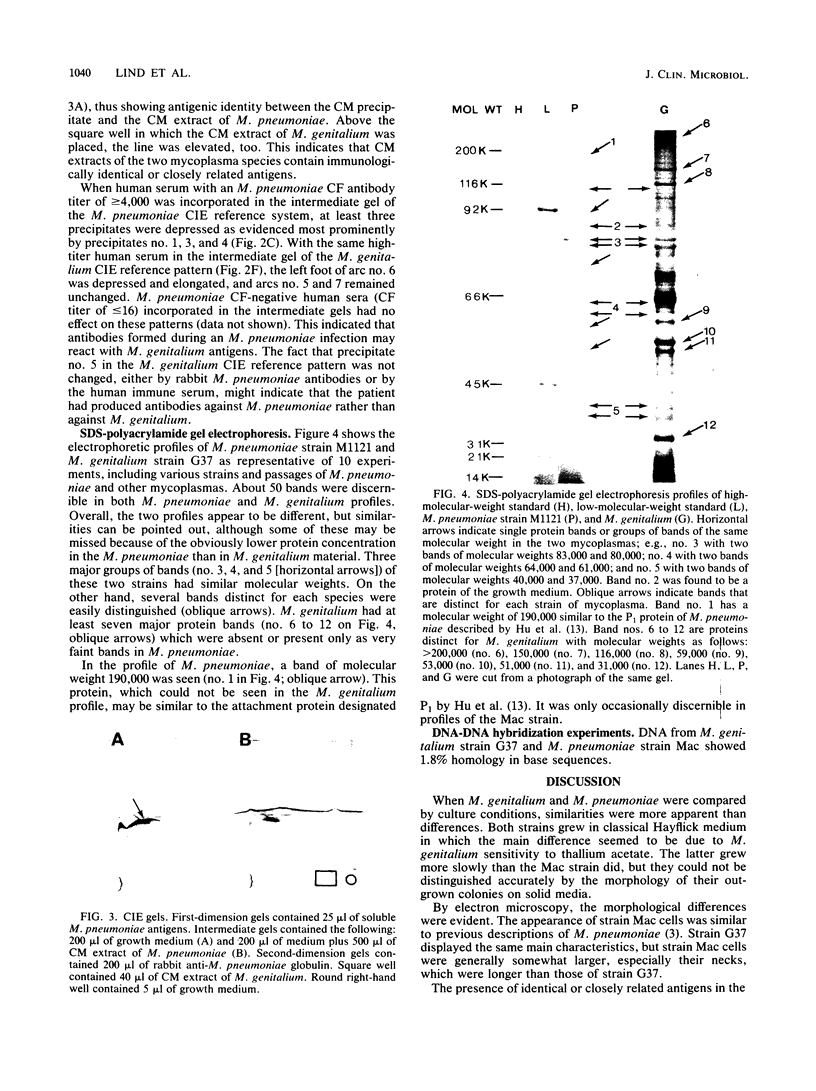
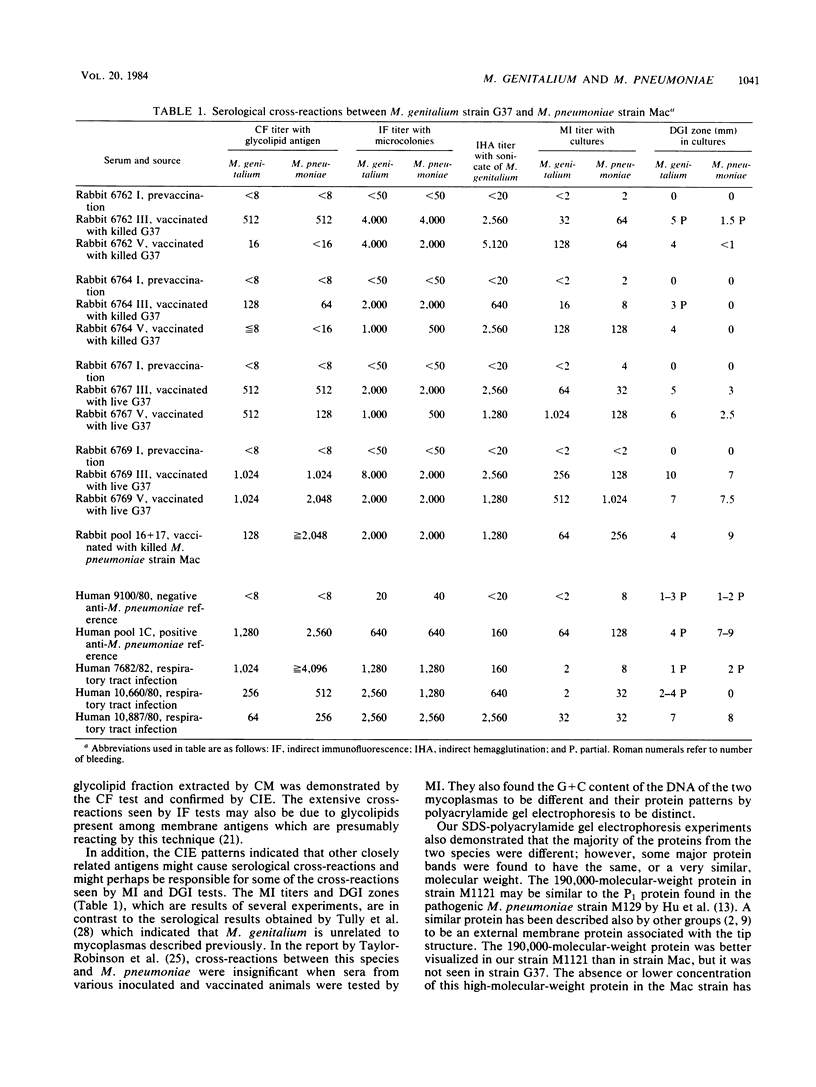
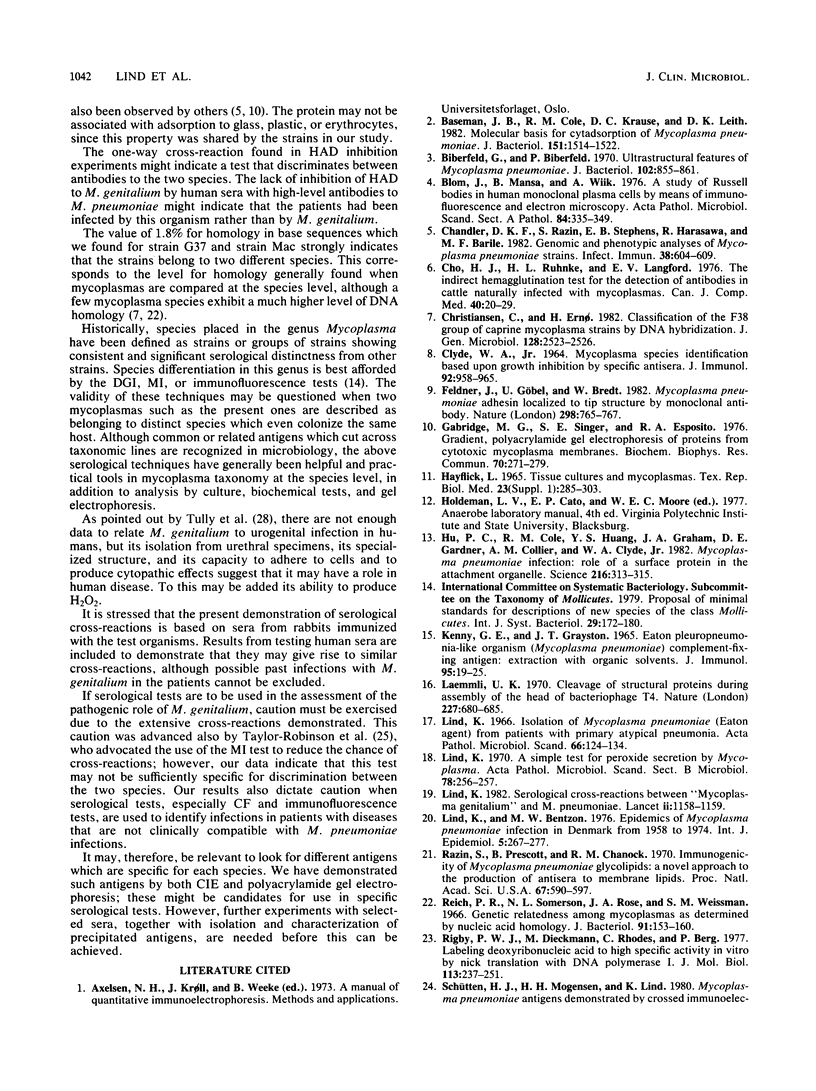
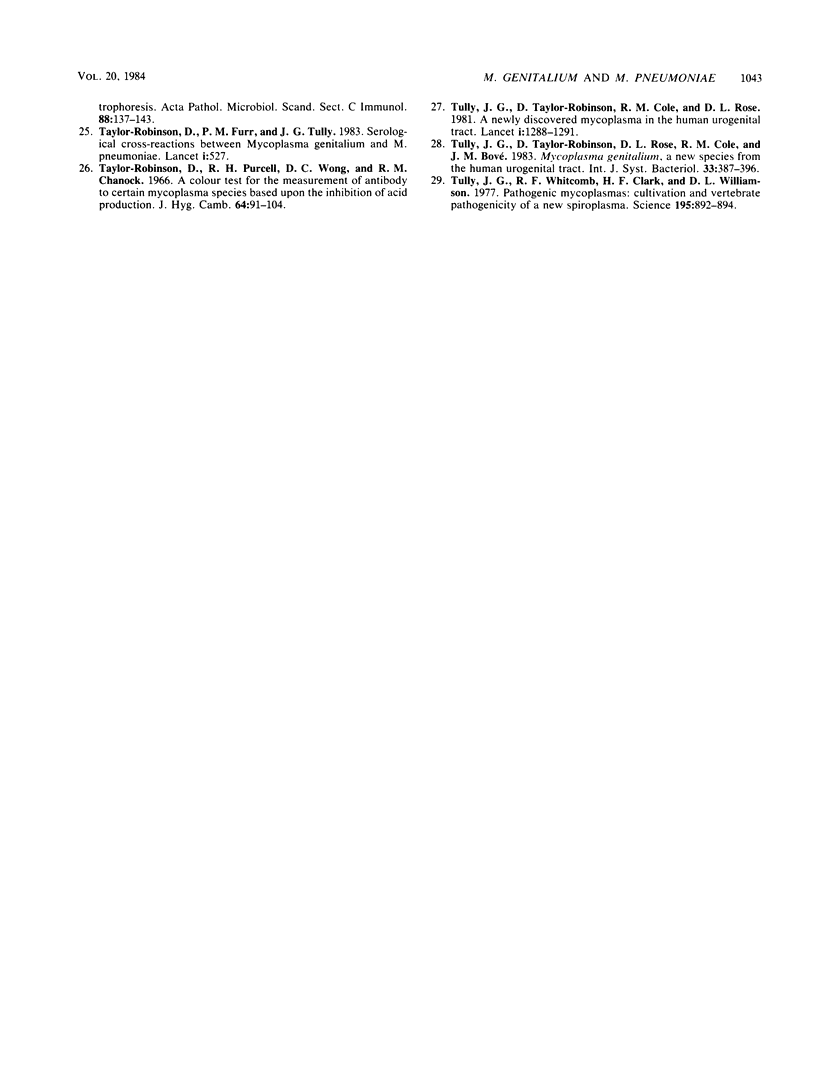
Images in this article
Selected References
These references are in PubMed. This may not be the complete list of references from this article.
- Baseman J. B., Cole R. M., Krause D. C., Leith D. K. Molecular basis for cytadsorption of Mycoplasma pneumoniae. J Bacteriol. 1982 Sep;151(3):1514–1522. doi: 10.1128/jb.151.3.1514-1522.1982. [DOI] [PMC free article] [PubMed] [Google Scholar]
- Biberfeld G., Biberfeld P. Ultrastructural features of Mycoplasma pneumoniae. J Bacteriol. 1970 Jun;102(3):855–861. doi: 10.1128/jb.102.3.855-861.1970. [DOI] [PMC free article] [PubMed] [Google Scholar]
- Blom J., Mansa B., Wilk A. A study of Russell bodies in human monoclonal plasma cells by means of immunofluorescence and electron microscopy. Acta Pathol Microbiol Scand A. 1976 Jul;84(4):335–349. doi: 10.1111/j.1699-0463.1976.tb00124.x. [DOI] [PubMed] [Google Scholar]
- CLYDE W. A., Jr MYCOPLASMA SPECIES IDENTIFICATION BASED UPON GROWTH INHIBITION BY SPECIFIC ANTISERA. J Immunol. 1964 Jun;92:958–965. [PubMed] [Google Scholar]
- Chandler D. K., Razin S., Stephens E. B., Harasawa R., Barile M. F. Genomic and phenotypic analyses of Mycoplasma pneumoniae strains. Infect Immun. 1982 Nov;38(2):604–609. doi: 10.1128/iai.38.2.604-609.1982. [DOI] [PMC free article] [PubMed] [Google Scholar]
- Cho H. J., Ruhnke H. L., Langford E. V. The indirect hemagglutination test for the detection of antibodies in cattle naturally infected mycoplasmas. Can J Comp Med. 1976 Jan;40(1):20–29. [PMC free article] [PubMed] [Google Scholar]
- Christiansen C., Ernø H. Classification of the F38 group of caprine Mycoplasma strains by DNA hybridization. J Gen Microbiol. 1982 Nov;128(11):2523–2526. doi: 10.1099/00221287-128-11-2523. [DOI] [PubMed] [Google Scholar]
- ENNY G. E., GRAYSTON J. T. EATON PLEUROPNEUMONIA-LIKE ORGANISM (MYCOPLASMA PNEUMONIAE) COMPLEMENT-FIXING ANTIGEN: EXTRACTION WITH ORGANIC SOLVENTS. J Immunol. 1965 Jul;95:19–25. [PubMed] [Google Scholar]
- Feldner J., Göbel U., Bredt W. Mycoplasma pneumoniae adhesin localized to tip structure by monoclonal antibody. Nature. 1982 Aug 19;298(5876):765–767. doi: 10.1038/298765a0. [DOI] [PubMed] [Google Scholar]
- Gabridge M. G., Singer S. E., Esposito R. A. Gradient, polyacrylamide gel electrophoresis of proteins from cytotoxic mycoplasma membranes. Biochem Biophys Res Commun. 1976 May 3;70(1):271–279. doi: 10.1016/0006-291x(76)91138-4. [DOI] [PubMed] [Google Scholar]
- Hayflick L. Tissue cultures and mycoplasmas. Tex Rep Biol Med. 1965 Jun;23(Suppl):285+–285+. [PubMed] [Google Scholar]
- Hu P. C., Cole R. M., Huang Y. S., Graham J. A., Gardner D. E., Collier A. M., Clyde W. A., Jr Mycoplasma pneumoniae infection: role of a surface protein in the attachment organelle. Science. 1982 Apr 16;216(4543):313–315. doi: 10.1126/science.6801766. [DOI] [PubMed] [Google Scholar]
- Laemmli U. K. Cleavage of structural proteins during the assembly of the head of bacteriophage T4. Nature. 1970 Aug 15;227(5259):680–685. doi: 10.1038/227680a0. [DOI] [PubMed] [Google Scholar]
- Lind K. A simple test for peroxide secretion by mycoplasma. Acta Pathol Microbiol Scand B Microbiol Immunol. 1970;78(2):256–257. doi: 10.1111/j.1699-0463.1970.tb04297.x. [DOI] [PubMed] [Google Scholar]
- Lind K., Bentzon M. W. Epidemics of Mycoplasma pneumoniae infection in Denmark from 1958 to 1974. Int J Epidemiol. 1976 Sep;5(3):267–277. doi: 10.1093/ije/5.3.267. [DOI] [PubMed] [Google Scholar]
- Lind K. Isolation of Mycoplasma pneumoniae (eaton agent) from patients with primary atypical pneumonia. Acta Pathol Microbiol Scand. 1966;66(1):124–134. doi: 10.1111/apm.1966.66.1.124. [DOI] [PubMed] [Google Scholar]
- Lind K. Serological cross-reactions between "Mycoplasma genitalium" and M. pneumoniae. Lancet. 1982 Nov 20;2(8308):1158–1159. doi: 10.1016/s0140-6736(82)92809-4. [DOI] [PubMed] [Google Scholar]
- Razin S., Prescott B., Chanock R. M. Immunogenicity of Mycoplasma pneumoniae glycolipids: a novel approach to the production of antisera to membrane lipids. Proc Natl Acad Sci U S A. 1970 Oct;67(2):590–597. doi: 10.1073/pnas.67.2.590. [DOI] [PMC free article] [PubMed] [Google Scholar]
- Reich P. R., Somerson N. L., Rose J. A., Weissman S. M. Genetic relatedness among mycoplasmas as determined by nucleic acid homology. J Bacteriol. 1966 Jan;91(1):153–160. doi: 10.1128/jb.91.1.153-160.1966. [DOI] [PMC free article] [PubMed] [Google Scholar]
- Rigby P. W., Dieckmann M., Rhodes C., Berg P. Labeling deoxyribonucleic acid to high specific activity in vitro by nick translation with DNA polymerase I. J Mol Biol. 1977 Jun 15;113(1):237–251. doi: 10.1016/0022-2836(77)90052-3. [DOI] [PubMed] [Google Scholar]
- Schütten H. J., Mogensen H. H., Lind K. Mycoplasma pneumoniae antigens demonstrated by crossed immunoelectrophoresis. Acta Pathol Microbiol Scand C. 1980 Jun;88(3):137–143. doi: 10.1111/j.1699-0463.1980.tb00086.x. [DOI] [PubMed] [Google Scholar]
- Taylor-Robinson D., Furr P. M., Tully J. G. Serological cross-reactions between Mycoplasma genitalium and M. pneumoniae. Lancet. 1983 Mar 5;1(8323):527–527. doi: 10.1016/s0140-6736(83)92212-2. [DOI] [PubMed] [Google Scholar]
- Taylor-Robinson D., Purcell R. H., Wong D. C., Chanock R. M. A colour test for the measurement of antibody to certain mycoplasma species based upon the inhibition of acid production. J Hyg (Lond) 1966 Mar;64(1):91–104. doi: 10.1017/s0022172400040377. [DOI] [PMC free article] [PubMed] [Google Scholar]
- Tully J. G., Taylor-Robinson D., Cole R. M., Rose D. L. A newly discovered mycoplasma in the human urogenital tract. Lancet. 1981 Jun 13;1(8233):1288–1291. doi: 10.1016/s0140-6736(81)92461-2. [DOI] [PubMed] [Google Scholar]
- Tully J. G., Whitcomb R. F., Clark H. F., Williamson D. L. Pathogenic mycoplasmas: cultivation and vertebrate pathogenicity of a new spiroplasma. Science. 1977 Mar 4;195(4281):892–894. doi: 10.1126/science.841314. [DOI] [PubMed] [Google Scholar]



